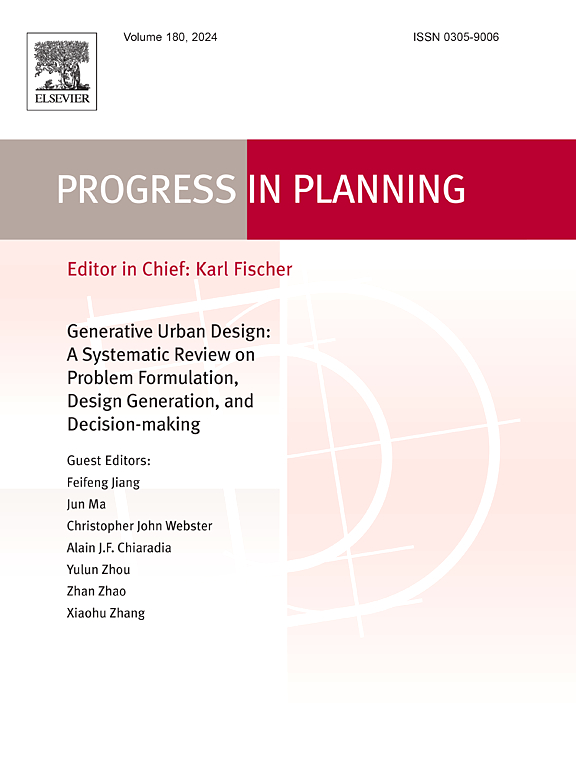Biophilic street design for urban heat resilience
IF 5.7
1区 经济学
Q1 ENVIRONMENTAL STUDIES
引用次数: 0
Abstract
Cities are facing urban heat problems which have significant environmental, economic, and social impacts. Environmental deterioration is another challenge threatening cities. To avoid hazardous environmental exposure, citizens increase the reliance on indoor space while this causes an emerging challenge to human health and wellbeing. Addressing more than one challenge in an urban context is essential. Preparing for an increasingly hot era is urgent for both developing and developed nations to mitigate negative consequences, and there is a need of biophilic design to integrate humans and nature. However, few studies have explored the integration of heat–resilient design and biophilic design. This study aims to address this gap by developing a framework for heat–resilient biophilic street (HERBST) design, where the street is highlighted for its key role in public activity. This study delineates biophilic theory and outlines biophilic street design elements, activities, attitudes and knowledge, and institutions and governance based on literature review. Afterwards, this study analyses heat–resilient street design in terms of design goals, implementation pathways, and issues addressed to clarify the potential of integrating biophilic street design and heat–resilient street design. Furthermore, this study reveals the relevance and complementarity between the two and defines the HERBST framework. In particular, the HERBST framework aims to reduce heat stress for pedestrians, increase the time people spend outdoors, increase social interaction, and alleviate heat-related physical and mental health problems while strengthening the connection between people and nature. The technical pathway of the HERBST framework is categorized into heat mitigation, adaptation, and management. Heat mitigation includes measures for transport planning, road facilities, building facades, and pocket parks; heat adaptation is linked to lifestyles, multi-sensory experiences, mental health, and social connectivity; and heat management is linked to governance systems, economic structures, and advocacy and education. The HERBST framework implementation is elucidated through site analysis, goal setting, planning and design, implementation, maintenance and management, and post-occupancy evaluation. Finally, this study discusses the research, design, cognitive, social, cultural, institutional, regulatory, and economic barriers associated with HERBST and provides recommendations. Overall, this study presents an innovative, coordinated, and implementable solution to urban extreme heat and environmental deterioration.
城市抗热性的亲生物街道设计
城市正面临着具有重大环境、经济和社会影响的城市热问题。环境恶化是威胁城市的另一个挑战。为了避免危险的环境暴露,市民增加了对室内空间的依赖,这给人类的健康和福祉带来了新的挑战。在城市环境中解决多个挑战至关重要。发展中国家和发达国家都迫切需要为日益炎热的时代做好准备,以减轻负面影响,并且需要亲生物的设计来整合人与自然。然而,很少有研究探讨热适应性设计与亲生物设计的结合。本研究旨在通过开发一个热弹性亲生物街道(HERBST)设计框架来解决这一差距,其中街道因其在公共活动中的关键作用而得到强调。本研究在文献综述的基础上,勾勒出亲生态的街道设计要素、活动、态度和知识、制度和治理。随后,本研究从设计目标、实施路径和需要解决的问题等方面对热韧性街道设计进行了分析,以阐明将亲生物街道设计与热韧性街道设计相结合的潜力。此外,本研究揭示了两者之间的相关性和互补性,并定义了HERBST框架。特别是,HERBST框架旨在减少行人的热应激,增加人们在户外度过的时间,增加社会互动,缓解与热有关的身心健康问题,同时加强人与自然之间的联系。HERBST框架的技术途径分为热缓解、适应和管理。减少热量的措施包括交通规划、道路设施、建筑物外墙和袖珍公园;热适应与生活方式、多感官体验、心理健康和社会联系有关;热管理与治理系统、经济结构、宣传和教育有关。HERBST框架的实施通过场地分析、目标设定、规划和设计、实施、维护和管理以及使用后评估来阐明。最后,本研究讨论了与HERBST相关的研究、设计、认知、社会、文化、制度、监管和经济障碍,并提出了建议。总体而言,本研究提出了一个创新的、协调的、可实施的解决方案,以应对城市极端高温和环境恶化。
本文章由计算机程序翻译,如有差异,请以英文原文为准。
求助全文
约1分钟内获得全文
求助全文
来源期刊

Progress in Planning
Multiple-
CiteScore
10.70
自引率
1.60%
发文量
26
审稿时长
34 days
期刊介绍:
Progress in Planning is a multidisciplinary journal of research monographs offering a convenient and rapid outlet for extended papers in the field of spatial and environmental planning. Each issue comprises a single monograph of between 25,000 and 35,000 words. The journal is fully peer reviewed, has a global readership, and has been in publication since 1972.
 求助内容:
求助内容: 应助结果提醒方式:
应助结果提醒方式:


